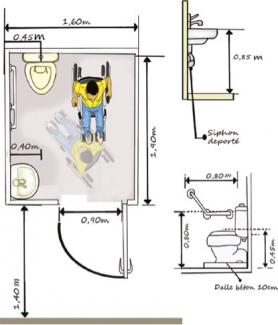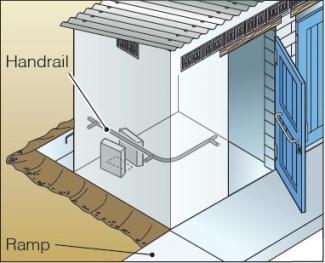To ensure there is safe access to latrines for all:
-
Construct them in well lit and safe areas, so women and children can access them safely. Make sure to provide separate and accessible female latrines.
-
Construct them no further than 30m away from shelters or settlements. In unexpected, short-term emergency situations, no further than 50 m away from shelters.
-
On average, construct 1 in 10 latrines fully barrier-free for persons with disabilities and older persons and others as accessible as possible.
-
Ensure all accessible facilities are marked with large access symbols.
-
Ensure that hazardous areas are marked and fenced.
-
Ensure information about the available latrines is disseminated using appropriate means of communication.
Minimum standards for accessible transitional or mobile emergency latrines:
A transitional or mobile latrine during initial phase of emergency response should have a space of at least 120 cm x 120 cm but ideally 180 cm x 180 cm. The door should be at least 90 cm wide and open outwards with a large lever handle (no round handle) and a rope inside for closing. Locks should be easy to handle for persons with grip difficulties, use sliding or revolving metal or wooden bolts.
Make sure to include a free area (of a size of at least 80 cm x 130 cm) next to the toilet seat for a wheelchair user to be able to transfer from a wheelchair to the seat or with support from an assisting person. If possible, a free space of 150 cm x 150 cm should be provided so that a wheelchair can make a complete turn.
Grabrails should be installed to support people's transfer (it could be made of strong plastic tubes if iron is not available) at a height of 80 cm above the ground and be strong enough to support body weight.
The toilet seat or type of latrine can be shaped differently according to customs and habits and should be decided in consultation with the concerned population, including persons with disabilities.

